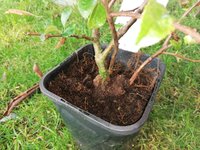Wires_Guy_wires
Imperial Masterpiece
I bought a 7 dollar pink quince to play with and I found a potato beneath the surface.

Is this potato something I can use? Should it be buried for a couple years? Can I keep it uncovered?
I know nothing about C. Japonica so I could use some advice on what to do with this.
I have no problems with turning it into a clump or whatever.. I'm fine with it getting bigger, also with keeping it as is.

Is this potato something I can use? Should it be buried for a couple years? Can I keep it uncovered?
I know nothing about C. Japonica so I could use some advice on what to do with this.
I have no problems with turning it into a clump or whatever.. I'm fine with it getting bigger, also with keeping it as is.
